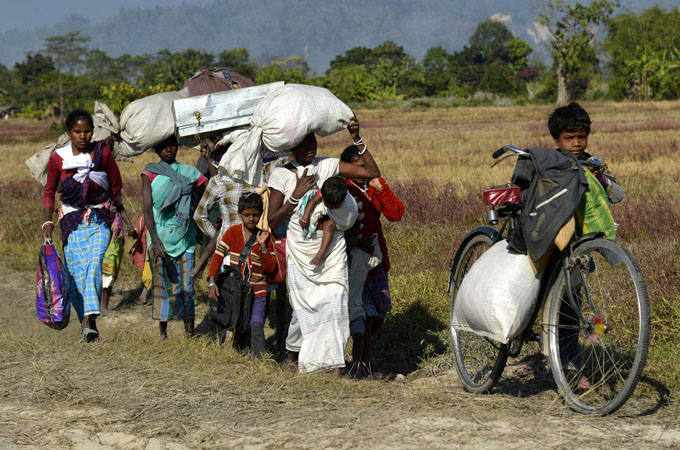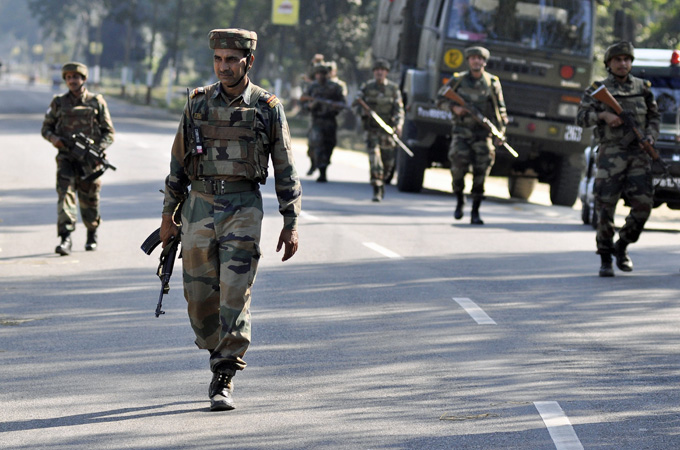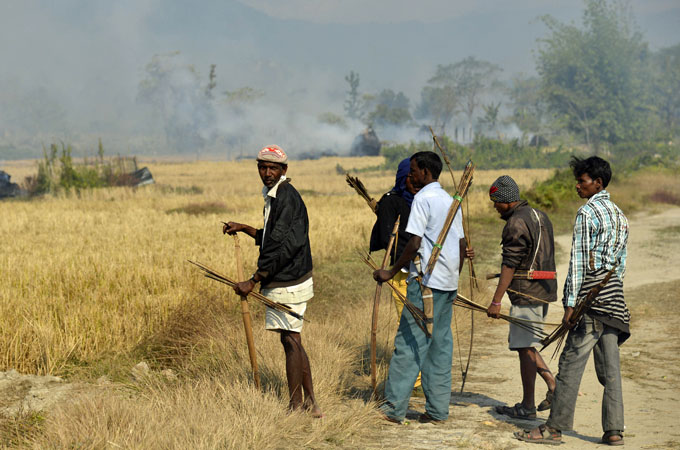New massacre fears grow in ‘India’s Bosnia’
Survivors of ethnic bloodshed in restive Assam state decry government neglect and warn of more rebel attacks.

Alipurduar, India – Displaced survivors of an ethnic massacre in Assam state that killed at least 80 tribespeople late last month say they are facing a huge humanitarian crisis and fears are high of new attacks by their rivals.
The number of internally displaced people has swelled with tens of thousands of Adivasi – a term describing the many ethnic and tribal groups in India‘s northeast – now fleeing their villages after the December massacre to safer areas in the west of troubled Assam state.
The New Delhi-based Asian Centre for Human Rights (ACHR) now puts the number of internally displaced in Assam at more than 300,000.
The mass killing of civilians – including women and children – has been blamed on armed fighters from the National Democratic Front of Bodoland, which has pressed for self-rule for members of the Bodo tribe who say they’ve long been marginalised.
 |
| Adivasi people burn the houses of Bodos in response to an attack that killed about 80 people in December [Biju Boro] |
Assailants armed with assault rifles and dressed in military uniforms attacked four villages simultaneously on December 23, killing dozens.
Massacre survivors said there is not enough food and safe drinking water in makeshift camps now housing them, nor enough warm clothes and blankets as they endure a freezing-cold January.
Pregnant women are delivering babies without elementary healthcare support, and lactating mothers have barely any milk for infants.
Fearing an outbreak of disease, the Indian government dispatched a team of health officials last week to evaluate the humanitarian crisis building up in 85 makeshift camps in four districts of western Assam state.
“But we still hardly have any healthcare on ground so far,” Tina Kerketta, a displaced person at a camp in Chirang district, told Al Jazeera.
What worries the displaced people most, however, is a lack of security at the camps.
 |
| Adivasi villagers carry their belongings after deadly attacks allegedly by a Bodo rebel faction [Biju Boro/Al Jazeera] |
“There are few policemen to guard our camps and we fear we may be attacked again,” said Manuel Lakra, a local tribal leader uprooted from his village during the December massacre.
Lakra is a Santhal – one of the many tribes known collectively as Adivasi – whose ancestors were brought to Assam from central India by British colonialists to work in hundreds of the region’s thriving tea plantations.
Now, many Adivasi have taken over and started farming land that once belonged to indigenous Bodo tribespeople.
“The land alienation is the main trigger for the ethnic conflict in Assam,” said Uddipana Goswami, a social scientist who has studied the history of Assam.
She described the area as a “tinderbox” because conflicts between Bodos and non-Bodos have repeatedly flared since 1992.
 |
| Indian soldiers patrol in Sonitpur district in Assam on December 26, 2014 after the ethnic massacre [Biju Boro/Al Jazeera] |
An Indian defence journal last month described Assam as “India’s Bosnia”, flagging the frequent eruption of ethnic conflict in the northeastern state since India became independent from Britain in 1947.
More than a quarter of a million Santhals were displaced during large-scale violence unleashed by Bodo fighters in 1996. Hundreds were killed as Santhals fought back.
In May this year, Bodo rebels killed more than 30 Muslims of Bengali origin in an attack on some villages.
That was after India’s national parliamentary elections, in which a non-Bodo candidate emerged victorious for the first time by winning the Kokrajhar parliament seat in western Assam.
Kokrajhar is the administrative headquarters of the Bodoland Territorial Council, and the parliament seat had always been won by Bodo politicians. Various non-Bodo communities – such as ethnic Assamese, Bengali Muslims and Hindus, and Nepalese and Santhal tribes, who have faced regular Bodo rebel attacks – had joined together to support a former Assamese rebel leader, Naba Sarania.
 |
| Angry Adivasi torch houses of the Bodo community in revenge after deadly attacks [Biju Boro/Al Jazeera] |
While the Bodo vote was split between three candidates from their tribe, the consolidation of the non-Bodo vote ensured Sarania’s victory.
“Many saw that as negating the Bodo claim for a separate state at a time when they were trying to intensify it in the wake of India creating a separate state of Telengana in southern India,” said Assam-based columnist Samir Purkayastha.
“That was sure to intensify the ethnic conflict all the more.”
In the summer of 2012, Bodo fighters attacked scores of Bengali Muslim villages that left hundreds dead and nearly 300,000 displaced.
Last week, those living in the camps had similar stories to tell – that the Assam government has failed to provide much-needed aid including warm clothes, baby food, and safe drinking water .
Sanitation facilties in the camps are almost non-existent. “They are living in unbelievably horrible conditions,” said Asian Centre for Human Rights chairperson Suhas Chakma.
 |
| Violence between the Bodo and non-Bodo communities has raged for decades [Biju Boro/Al Jazeera] |
Earlier in the week when Assam Chief Minister Tarun Gogoi visited a relief camp east of the Beki river with a security force of 300 police and paramilitary troops guarding his convoy, Lakra said there was anger among the displaced.
“Only if we had one-third of that force in our area, the massacres could have been avoided,” Lakra recalled one survivor saying.
The Assam government blamed the December 23 assault – four simultaneous attacks on as many villages within in an hour – on armed rebels of the Bodo tribe.
The Bodos enjoy considerable autonomy in the Territorial Council, created in western Assam as a result of a 2003 peace deal with the Indian government.
But some Bodo groups have pushed for a separate state, while the National Democratic Front of Bodoland (NDFB) wants outright independence.
While the NDFB’s chairman Ranjan Daimary is now negotiating with the government in New Delhi, a rival faction led by Songbijit – which is blamed for the pre-Christmas massacre – has refused to call off the armed movement.
 |
| Adivasi people carry their belongings as they flee from the village of Tenganala after their relatives were killed [Biju Boro] |
Assam police official LR Bishnoi said the rebels were desperate to hit back after many were killed during operations launched by army and police in December.
“We have killed or captured many of their activists. That has made them desperate to strike back,” Bishnoi said.
That, say counterinsurgency analysts, is a favourite tactic of northeast guerrilla groups when they come under pressure.
“When the security forces launch offensive operations against a rebel group in India’s northeast, they often attack villagers of a rival tribe and kill many of them,” said Major-General Gaganjit Singh, who previously commanded a mountain division in western Assam.
“That forces us to call off offensive operations and disperse our forces for static village guarding duties. That takes the heat off the rebels.”
Assam is one of seven states in India’s northeast, a region bounded by China, Myanmar, Bhutan and Bangladesh. For long, residents have accused the central government of plundering its natural resources and ignoring development.